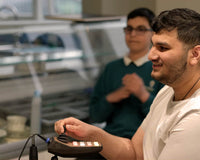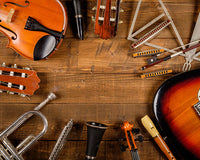Yes, the Violin can physically be restrung into a left handed violin and a left-handed chin rest provided. Yet even this does not make it a proper LH instrument. All will be revealed! But will being left-handed be an asset or a hazard? Knowing how to play the Violin is a wonderfully beneficial skill that has lifelong advantages. However, many “south-paws” are confused about whether or not they can be trained on the instrument, and are curious to know if a left-handed Violin will be a hindrance or a help. 
Traditional Teaching
The violin is traditionally played by placing it on the left shoulder, balancing the neck using the left hand, and bowing with the right arm. Since the bowing action is extremely important to controlling the sounds, people who are right-handed are able to use their dominant arm to perform this task. The position of the fingers is minor when compared with the action of the bow, relative to the music you can produce. So naturally, having the bow in your right hand (if you’re right-handed) makes it easier when learning to play the violin. That’s simply the way the violin is made; and for many years, there wasn’t any other option. However recently, there’s been more emphasis on assisting left-handed students who want to learn. Various luthiers (the craftspeople who create string instruments) and instrument brands have begun to fashion left-handed violins for left-handed students.Left-Hand Drive
A left-handed violin is the mirror image of a standard violin. It is a reflection, not an opposite. You shouldn’t turn a standard violin into a left-handed one by simply putting the strings on in reverse. Violins are crafted very specifically. Inside the body, a bass bar (a wooden slat) runs the length of the strings, under the right leg of the bridge (in a left-handed violin). Similarly the soundpost is under the left side. The ‘reverse’ location of the strings requires that the peg holes are crafted suitably as well. Therefore, if you need a left-handed violin, you must buy or rent it, you shouldn't really alter a standard one.Things To Consider
As mentioned, if you are left-handed, learning to play violin on a left-handed instrument can make the initial training easier. Because your left arm is dominant, the bowing techniques will be performed by that side, and you’ll basically just need to train your right hand for making the right positions on the fingerboard. For years, left-handed students were simply taught the traditional way, with no regard to preference. However, to achieve your maximum potential, it can be hard to train your non-dominant arm to perform with excellence. If you’re wondering whether or not to learn with a left-handed violin, things that should be considered include:
- Are you interested in playing in an orchestra setting? A left-handed violin will require special consideration, and need to be situated so that your playing doesn’t interfere with others.
- Are you interested in pursuing a brilliant solo career, or playing in a professional group? A left-handed violin will give you the opportunity to fully develop your virtuosity.
- Is learning to play violin something that you’re doing for yourself, to gain personal fulfilment, or to round out a college application?
- Does your instructor feel comfortable teaching you to play on a left-handed instrument?
Summary
The answers to these questions should help you decide which instrument to choose. Essentially, learning to play violin must be a personal commitment, and you should choose an instrument that makes you feel comfortable. Otherwise, you’ll build an antipathy for it, which will severely stunt your progress. Learning to play violin is a challenge, whether you are left-handed or right-handed. You pretty much have to train your entire body to make new movements, which takes time and lots of practice. With a standard violin, your left-hand will make easy progress with correct fingering and it will feel very natural to hold the instrument on that side. However, your bowing arm will need to work overtime to develop the correct techniques. Alternately, if you choose a left-handed violin, the entire process will seem foreign, much like it does for everyone else. Either way, choosing to learn the violin is an excellent decision, and one that will benefit you your entire life. Personally, I am on the side of the majority of teachers I have ever met; always play a traditional right-handed Violin.




















